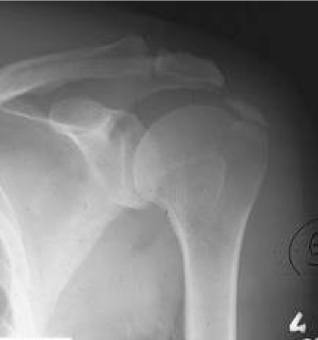Back to: Trial Questions
Question
35yrs, female with severe pain in the shoulder
Describe the xray
How would you treat this patient acutely, and in the long term?
This is an AP radiograph of a shoulder. There is a well rounded calcification, with no sign of a trabecular pattern. I would like to see further views, but the initial findings would suggest calcific tendonitis. How would you treat this patient in A&E? I would initially take a history and perform an appropriate examination. The patients often present acutely with severe pain and therefore pain management with NSAIDs and corticosteroid injections would be my first line of management. Once the pain is controlled, the patient can be offered physiotherapy. The patient responds well to initial treatment, but 6 months later she presents again in your orthopaedic outpatient clinic with moderate pain and mechanical symptoms of crepitus. A further xray demonstrates an almost translucent appearance of the calcification. What other treatment options may you offer? I would proceed by taking a further history, specifically inquiring about all the treatment received so far. On examination I would assess specifically for symptoms of subacromial impingement which may be associated with calcific tendonitis. Following refractory symptoms to nonoperative management I would consider offering an ultrasound guided needle barbotage. A systematic review by Gatt et al 2014 has demonstrated that this a safe technique, with high success rates and low complication rate. Furthermore an arthroscopic or mini-open approach can be utilised for decompression of the calcium deposits. Additionally a subacromial decompression and/or a rotator cuff repair may be consider in the same sitting. Ultrasound-guided barbotage for calcific tendonitis of the shoulder: a systematic review including 908 patients Review published: 2014. Bibliographic details: Gatt DL, Charalambous CP. Ultrasound-guided barbotage for calcific tendonitis of the shoulder: a systematic review including 908 patients. Arthroscopy 2014; 30(9): 1166-1172.Answer

